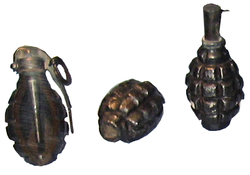F1 grenade (France)
| F-1 Grenade | |
|---|---|

From left to right: F1 with M1916 Billant fuse, F1 body, F1 with percussion fuse.
|
|
| Type | Percussion, time-fused grenade |
| Place of origin | France |
| Service history | |
| In service | 1915–1940 |
| Used by | France, Commonwealth of the Philippines, United States of America, Finland, Russian Empire, Soviet Union |
| Wars | World War I, Russian Civil War, Winter War and World War II |
| Production history | |
| Designer | Unknown |
| Designed | 1915 |
| Produced | 1915–1940 |
| Specifications | |
| Weight | 530g/550g/570g /600g (Vary from sources) |
| Length | 90 mm (without fuse) |
|
|
|
| Filling | Cheddite (World War I model), Trinitrotoluene (TNT) |
| Filling weight | 60g |
|
Detonation
mechanism |
Timed Friction Fuse |
The F-1 grenade is a hand grenade mass-produced by France during and after WW1, used en masse in the majority of European countries throughout the First World War and Second World War.
The F-1 grenade was first put into mass production by the French State in 1915 during the First World War. In May 1915 the first of the F1 grenades (fusante №1) appeared in the French Military, in limited quantities. This new weapon inherited from the experience of the first months of the war: the shape was made to be more modern, with an external grooves pattern for better grip and easier fragmentation. The second expectation proved deceptive, since the explosion in practice gave no more than 10 fragments (although the pattern was designed to split into all the 38 drawn divisions). The design was proved to be very functional, especially due to its stability compared to other grenades of the same period. Later the Fusante №1 was used en masse by many foreign armies in the period from 1915 - 1940. The F-1 grenade has been used as a basis for the development of many other grenades by different nations, including the US and the USSR. It is the most recognisable grenade of the 20th century.
The F-1 was very widespread during the first half of the 20th century, used by armies of France, United States, Imperial Russia, Soviet Russia, Finland, and others. Overall more than 60,000,000 (sixty million) grenades were produced over 25 years, from 1915 - 1940.
Originally, the F1 was designed to use a lighter-based ignition system, but later it began using a percussion cap fuse. Designs such as the M1916 and M1917 Billant fuses turned the F1 into a time-fused grenade, which was the grenade's final ignition system. By World War II, the F1 used the M1935 fuse, which is a time-based fuse, but it differs from the M1916 Billant fuse internally. The F-1 in its original design was withdrawn from French military service in 1946. The altered models of the grenade remain in military service in countries around the world, among others in the Russian F1 Grenade and American Mk 2 grenade.
The French F-1 grenade with the M1916 Billant fuse was the preferred grenade by the American Army during World War I. The F-1 inspired both the failed American Mk 1 grenade, and the iconic Mk 2 grenade that followed it, introduced in 1920 and used in the US military into the 1970s; it can still be found in service today, although no longer as widespread.
...
Wikipedia
